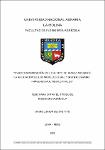Mostrar el registro sencillo del ítem
Evapotranspiración del cultivo de arroz mediante la aplicación de los modelos Sebal y Metric usando imágenes multiespectrales
| dc.contributor.advisor | Ramos Fernández, Lía | |
| dc.contributor.advisor | Arapa Quispe, José Bernardino | |
| dc.contributor.author | Quispe Tito, David Junior | |
| dc.date.accessioned | 2022-01-17T16:30:59Z | |
| dc.date.available | 2022-01-17T16:30:59Z | |
| dc.date.issued | 2021 | |
| dc.identifier.uri | https://hdl.handle.net/20.500.12996/5169 | |
| dc.description | Universidad Nacional Agraria La Molina. Facultad de Ingeniería Agrícola. Departamento Académico de Recursos Hídricos | es_PE |
| dc.description.abstract | La estimación de la evapotranspiración con teledetección, se inició con apoyo de imágenes satelitales, sin embargo, el avance tecnológico, está permitiendo incorporar nuevas plataformas de obtención de imágenes, como las imágenes obtenidas con aeronaves pilotadas remotamente RPA, que permiten mejorar la resolución temporal y espacial de las imágenes, por ello que se realizó el presente trabajo de investigación, en el aérea experimental de riego de la UNALM, cuyo objetivo fue estimar la evapotranspiración del cultivo de arroz en tres variedades¸ V1: IR43, V2: IR71706 y V3: Sahood Ulan 12, aplicando el modelo Surface Energy balance Algorithms for Land: SEBAL ; y el modelo Mapping EvapoTranspiration at high Resolution with Internalized Calibration METRIC, a partir de la captura de imágenes de cámaras multiespectrales y cámaras térmicas, montadas en RPA tipo multirotor de clase cuadricóptero, realizando un total 9 vuelos; asimismo se realizó una correlación de índices de vegetación diferencial normalizado NDVI e índice de área foliar IAF, con dos sensores de mano: Green Seaker y Ceptómetro y una calibración de temperatura con termopares instaladas en el dosel del cultivo, en condiciones de humedad de suelo a saturación constante (E1) y entre saturación y capacidad de campo (E2); del que se obtuvo valores de media de ETc de 2.27 mm d-1 para E1 y 1.73 para E2 con el modelo SEBAL y 2.27 mm d-1 para E1 y 1.73 para E2 con el modelo METRIC, durante la fase de macollamiento del cultivo; se realizó la prueba ANOVA con p ≤ 0.05, no habiendo diferencia significativa entre tratamientos del mismo experimento, pero si entre experimentos. | es_PE |
| dc.description.abstract | The estimation of evapotranspiration with remote sensing began with the support of satellite images, however, technological progress is allowing the incorporation of new imaging platforms, such as images obtained with remotely piloted RPA aircraft, which allow improving the temporal resolution and This is why the present research work was carried out in the experimental irrigation area of UNALM, whose objective was to estimate the evapotranspiration of the rice crop in three varieties¸ V1: IR43, V2: IR71706 and V3: Sahood Ulan 12, applying the model Surface energy balance algorithms for the earth: SEBAL; and the Mapping EvapoTranspiration model at high Resolution with Internalized Calibration METRIC, from the capture of images from multispectral cameras and thermal cameras, mounted on quadcopter-class multirotor RPA, performing a total of 9 flights; A correlation of normalized differential vegetation indices NDVI and IAF leaf area index was performed with two hand sensors: Green Seaker and Ceptometer and a temperature calibration with thermocouples installed in the crop canopy, under saturated soil moisture conditions. constant (E1) and between saturation and field capacity (E2); From which mean ETc values of 2.27 mm d-1 were obtained for E1 and 1.73 for E2 with the SEBAL model and 2.27 mm d-1 for E1 and 1.73 for E2 with the METRIC model, during the tillering phase of the crop; The ANOVA test was performed with p ≤ 0.05, with no significant difference between treatments of the same experiment, but between experiments. | en_US |
| dc.format | application/pdf | en_US |
| dc.language.iso | spa | es_PE |
| dc.publisher | Universidad Nacional Agraria La Molina | es_PE |
| dc.rights | info:eu-repo/semantics/embargoedAccess | en_US |
| dc.rights.uri | https://creativecommons.org/licenses/by-nc-nd/4.0/ | * |
| dc.subject | Oryza sativa | es_PE |
| dc.subject | Arroz | es_PE |
| dc.subject | Evapotranspiración | es_PE |
| dc.subject | Evaporación | es_PE |
| dc.subject | Imágenes por satélites | es_PE |
| dc.subject | Fotointerpretación | es_PE |
| dc.subject | Sensores | es_PE |
| dc.subject | Teledetección | es_PE |
| dc.title | Evapotranspiración del cultivo de arroz mediante la aplicación de los modelos Sebal y Metric usando imágenes multiespectrales | es_PE |
| dc.type | info:eu-repo/semantics/bachelorThesis | en_US |
| thesis.degree.discipline | Ingeniería Agrícola | es_PE |
| thesis.degree.grantor | Universidad Nacional Agraria La Molina. Facultad de Ingeniería Agrícola | es_PE |
| thesis.degree.name | Ingeniero Agrícola | es_PE |
| dc.subject.ocde | https://purl.org/pe-repo/ocde/ford#4.01.01 | es_PE |
| renati.author.dni | 46156523 | es_PE |
| dc.publisher.country | PE | es_PE |
| dc.type.version | info:eu-repo/semantics/publishedVersion | en_US |
| dc.date.embargoEnd | 2023-12-06 | |
| renati.advisor.orcid | https://orcid.org/0000-0003-3946-7188 | es_PE |
| renati.advisor.orcid | https://orcid.org/0000-0002-6143-5038 | es_PE |
| renati.advisor.dni | 07462206 | es_PE |
| renati.advisor.dni | 10075184 | es_PE |
| renati.type | https://purl.org/pe-repo/renati/type#tesis | es_PE |
| renati.level | https://purl.org/pe-repo/renati/level#tituloProfesional | es_PE |
| renati.discipline | 811096 | es_PE |
| renati.juror | Montalvo Arquiñigo, Néstor | |
| renati.juror | Ascencios Templo, David Ricardo | |
| renati.juror | Díaz Rimarachín, Jorge Luis |
Ficheros en el ítem
Este ítem aparece en la(s) siguiente(s) colección(ones)
-
IAG-RH Tesis [311]



